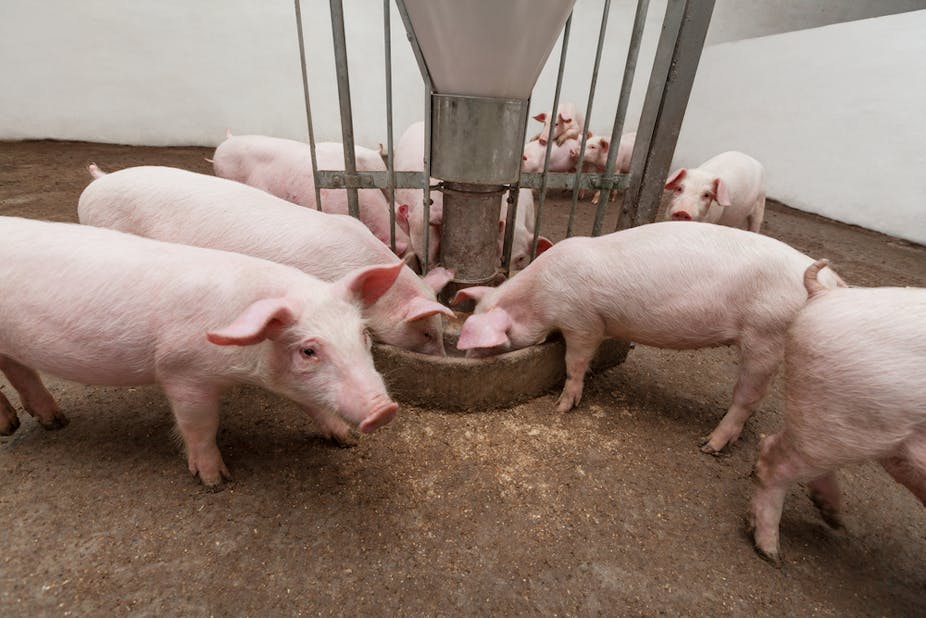Pork is one of the cheaper protein sources that can contribute towards food security in Africa. Pigs are omnivores, and as such are ideally suited to convert non human edible feed stuffs into high quality food animal protein. Pork consumption has grown tremendously over the years across the world, but production has not responded sufficiently to meet demand. It has been projected that almost 45% of additional pork consumption will be imported.
Pig numbers in Africa increased steadily from 33.8 million in 2013 to 34.5 million in 2014. But this rate will clearly not be sufficient to meet the demands of a growing population on the continent which currently stands at about 950 million people. Between 2013 and 2015 pork made up 12% of all meat consumed in sub Saharan Africa. This is much lower than poultry (36%), beef (33%) and sheep (19%). Cultural and religious concerns have largely limited pork consumption in many countries but urbanisation is changing this.
One of the major reasons for the lack of growth in pig production is high pig feed costs. Pig producers normally use a narrow range of ingredients which include maize, wheat, sorghum, soybean oilcake and sunflower oilcake among others in formulating pig diets. They are often forced to compete with humans and poultry for feed resources, making the cost of producing pigs prohibitive. Recurring droughts due to global warming are exacerbating the situation.
The other problem is that some high fibre diets aren’t the best for pig production. Pigs don’t grow as fast because some fibre – like wheat bran – reduces feed intake and dilutes the available protein, energy, minerals and vitamins necessary for growth. But not all fibres are the same: some are better than others.
To solve both the cost and the fibre issues the pig industry must find ways to effectively make use of readily available fibrous feeds from industries that process agricultural products. This would result in cheaper production of pigs and a more food secure continent.
What fibres work and which ones don’t
The major challenge in using fibrous feeds in pig diets is that pigs’ digestive enzymes can’t break down certain fibre components to a state that can be utilised by the animals. In addition, high fibre diets increase the rate of feed passage in the pig gut and trap nutrients in the fibre matrix making them unavailable for digestion. Fibre also imputes bulkiness to diets which limits the quantity of feed the pig can consume.
But fibres shouldn’t be grouped under a blanket term. Not all are a bad food choice for pigs. Fibres differ in their physical and chemical properties which affects the solubility of the fibre. Soluble and insoluble components of fibre differ in how they influence the number, range and types of microorganisms in the gut, fermentation patterns and absorption of nutrients.

A better understanding of these dynamics will lead to sustainable use of fibrous ingredients in pig diets. Sugar beet pulp, for example, is highly soluble and can be used at relatively high levels. Meanwhile wheat bran, which is highly insoluble, may be used in moderate quantities because of its laxative effects.
Pigs can also extract up to 25% of the energy they need from fibre fermentation products. This would mean that grains in their diets could be reduced. Besides the economic benefits from using cheaper fibrous byproducts in pig feed, there are also environmental gains. Most of these byproducts are often dumped inappropriately leading to water and air pollution.
The impact of fibrous diets
Most research has focused on the impact of the fibrous diets on growth performance of the pigs. But there is a need to quantify the beneficial effects of high fibre diets on intestinal health and welfare.
Dietary fibre improves pig health by promoting the growth of lactic acid bacteria, the “good bacteria”. These suppress the multiplication of disease causing bacteria like E. coli and Salmonella by lowering the pH in the pig intestines. This contributes to food safety because people can get E. coli and Salmonella from eating pig meat that’s been contaminated in this way, poisoning them.
Dietary fibre also reduces stress and behavioural problems in pigs. This is especially important given that intensive farming is increasingly being used to produce pigs. This has been shown to be quite stressful with detrimental effects on production. For example, sows appear to be less stressed and to move around less if they are physically and nutritionally satisfied.
Pigs can also use diets with high fibre better if enzymes that break down fibre are added to their diets. Another option is to allow the fibrous sources of pig feed to ferment under anaerobic conditions (without oxygen) – a process called ensiling. Ensiling breaks down fibre and also improves the taste of the feed.
Other approaches to break down the fibre matrix structure include fermentation and the use of fibre degrading enzymes or strong acids. These break down the fibre components to their basic constituents which is better for pigs. But the use of strong acids isn’t the best option because of safety, environmental and economic concerns.
There are many benefits to including fibrous ingredients in pig diets, but they are not accounted for in normal diet formulations. The evidence points to the fact that high fibre diets are good for pigs and should be used more than is currently the case.

